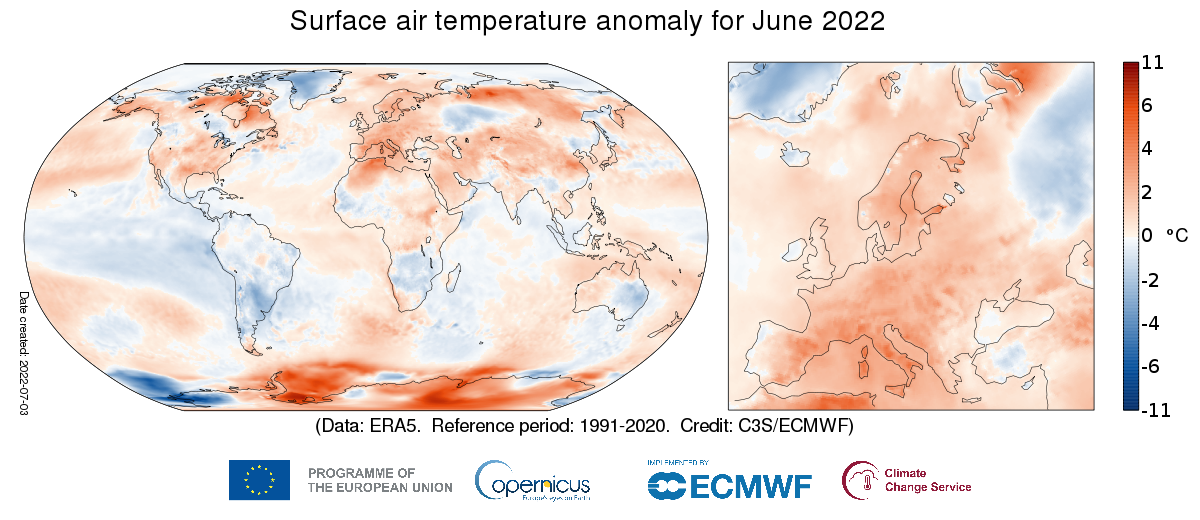
This article originally appeared on climate.copernicus.eu
The global average temperature for June 2022 was about 0.32ºC higher than the 1991-2020 average which makes it the third warmest June on record. Europe as a whole had its second warmest June on record at about 1.6ºC above average. Extreme temperatures occurred from Spain across France and into Italy; above-average temperatures were also experienced in China, Japan, and the USA Colder than average temperatures were seen over Greenland and most of South America.
In June 2022, temperatures were above the 1991-2020 average across most of Europe, with southern parts of the continent from the Iberian Peninsula across France and into Italy most affected. Daily maximum temperatures in Spain, France, and Italy soared above 40°C and the extreme heat exacerbated the ongoing drought conditions in the Po river basin. Numerous June temperature records were broken across France and Spain, with Biarritz, France, and San Sebastián, Spain, being two prime examples. This heat also extended across North Africa, where Tunisia equalled its monthly temperature record. Also, at Banak in northern Norway, a daily maximum temperature of 32.5°C was recorded, which if confirmed, would be a new June record for the county in which it is situated. Despite these record-breaking events, the monthly mean temperature for Europe was not the absolute warmest on record. In contrast, colder-than-average temperatures were experienced in western Russia, central Turkey, western areas of the Iberian Peninsula, and in Ireland.
Above-average temperatures were also found across Siberia and large parts of Asia, where heatwaves in central and northern China led to increased electricity demand. Temperatures of greater than 35°C were recorded for five days in a row in Tokyo, Japan, which is a record. In North America, high temperatures occurred in Texas, with Houston having its hottest June on record; San Antonio suffered from this extreme heat too. The Middle East also saw above-average temperatures. Temperatures were furthermore much higher than average over large parts of Antarctica and over the Weddell sea. Other regions of above-average temperature included northern Canada, central Africa, and western Australia.
June 2022 had much colder than average temperatures over Greenland, most of South America and especially Argentina, southern Africa, and across eastern Australia. Temperatures were also below the 1991-2020 average over several other land regions, including north-western Africa and small pockets of eastern Asia.
Near-surface air temperatures were mixed over parts of all the major ocean basins. Above-average temperatures occurred most prominently over the northeast Pacific and South Atlantic, while below-average marine air temperatures were located in the tropical and southern sub-tropical eastern Pacific, indicative of continuing La Niña conditions. Below-average temperatures were also experienced in the southern Indian Ocean to the south of Madagascar and Australia.
Globally, June 2022 was:
- 0.31°C warmer than the 1991-2020 average for June
- the third warmest June on record
- more than 0.05°C cooler than the warmest Junes, which were in 2019 and 2020
European average temperature anomalies are generally larger and more variable than global anomalies. The European average temperature for June 2022 was 1.57°C above the 1991-2020 average which makes the month the second warmest June in this data record. It was, however, 0.3°C colder than the warmest June, which occurred in 2019.
Temperatures averaged over the last twelve-month period were:
- above average over most land areas and the majority of the ocean surface
- markedly above the 1991-2020 average in a region stretching from northern Arabia to western Siberia, and over northern Siberia, central North America, north-western and central Africa, East Antarctica and the Weddell Sea
- above to average over much of Europe
- below average over some land areas, including parts of northern Canada and Alaska, north-eastern South America, southern Africa, Australia and Antarctica
- below average over the eastern equatorial Pacific, where the La Niña event that peaked in late 2020 reintensified later in 2021 and continued into 2022
- also below average over the Chukchi Sea, parts of the eastern North Pacific and several oceanic areas in the southern hemisphere.
Note on global values from ERA5 and other temperature datasets
The spread in global averages from various temperature datasets has been reported previously to have been relatively large over recent years. An updated version of the dataset principally responsible for this spread was released in mid-December 2020. This version agrees much better with other datasets for the latest few years. This version does however show a larger warming since 1850-1900 than its predecessor, which has an influence on the ‘pre-industrial’ estimate as mentioned above. Read more in the Temperature indicator.
There is general agreement among datasets that the period from 2015 to 2020 is much warmer globally than any previous such period. There is also agreement that the global temperature has risen at an average rate close to 0.2°C per decade since the late 1970s. There is nevertheless still some spread between the datasets for recent years, such as for 2020, and the annual average temperature anomalies for these years from ERA5 are generally higher than those from the five other datasets considered. The differences range from 0.02 to 0.08°C for 2016-2020. The range is 0.00 to 0.07°C if air temperature over sea is replaced by sea-surface temperature for ERA5 and the other dataset for which sea-surface temperature was not used by design. The remaining differences depend partly on the extent to which datasets represent the relatively warm conditions that have predominated over the Arctic and Antarctic during these years. Differences elsewhere in estimates of sea-surface temperature and surface air temperature over land have been further factors.
The average surface air temperature analysis homepage explains more about the production and reliability of the values presented here, but has yet to be updated to include the new information on dataset spread mentioned above.